Imagination was another one of those beautiful fanzines (in content and design) that seemed to fly before our eyes and disappear forever.
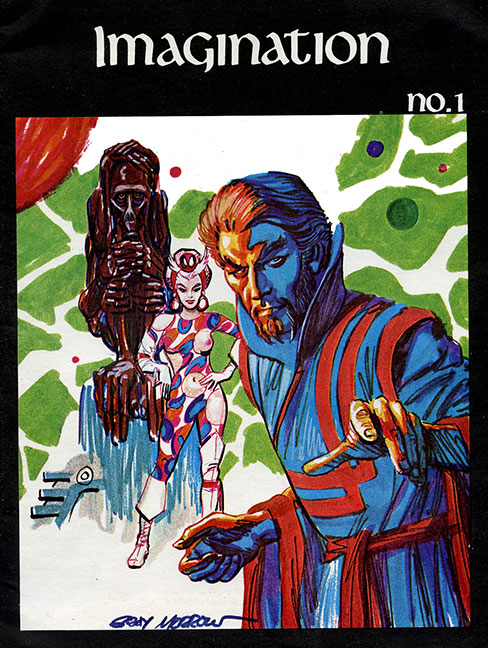
Imagination 1: 1971
Editor and publisher: David Jablin
As stated in the tag line, there were so many fanzines, of all levels of quality, that seemed to come and go in flashes. The surprise comes when a zine with such a high quality of contributors as this one does the same. Editor and publisher David Jablin has gone on to work a lot in television and film and provides some engrossing and entertaining reminisces generously given to me through email. The same can be said for main artist, Bill Stillwell.
Fanzine authority Emanuel Maris provided some valuable information about this zine also, by telling me there was actually an earlier, alternative edition, stating:
The first printing of Imagination 1 came out in time for the NY Lunacon in April ’71. I bought my copy at Jablin’s table at the ’71 NY [Seuling’s] Comic Art Convention in July. Jablin told me at that time that he was sending back the entire run right after the con to the printer, because the back cover by Stillwell was printed too dark for the fine pencil gradations to be revealed (indeed it was), and that he was revising the contents, so ‘buy this copy now before its destroyed.’ Unfortunately, in revising the contents, he did not change the introductory page 1 to include credits for the new material. Among items that differed was that the Al In Toiletland strip was tossed, as were some poetry pages, pages were shuffled, and the Lady Madona strip by Eric [Howard Chaykin] Pave and inker Stillwell was added, as well as Adam’s unpublished newspaper strip (printed sideways). The Nova Christus preview portfolio – in both editions – is by Chaykin. The actual Nova Christus strip, signed by Chaykin, appeared in Mark Wheatley’s Nucleus #7. Chaykin was credited in neither edition of Imagination 1.
At any rate, no reason to not dive right in and see some of the great work inside that, by design, illustrates the premise delivered by the title of the fanzine, and Jablin’s opening editorial. Right now, though, we can have a blast reading his answers to a few of my questions, with my questions included. To read the entire Jablin interview, see the link in the Imagination line within my Ink Stains section. Take my word, it is worth it. David put a lot of time into it, formatting it, adding graphics, etc.
Q: When and how old were you when you got into comics in general?
I was three years old when I picked up my first comic book. It was at a local barber shop in Flushing, Queens while reluctantly waiting for a haircut. Stuffed between some issues of Archie and Highlights magazine, was a well worn Superman comic — issue 113 to be precise. I can pinpoint this as the precise moment I was first transported to another universe. I couldn’t read it but I could somehow follow the story. I was so entranced that I didn’t even notice I was getting my haircut. Afterwards my mother took me right down the block to the corner candy store where I discovered that there were racks full of these amazing“comic books” stacked taller then I could even reach.
As I grew up, this corner candy store named Dottie’s would be my haunt for many years on the days when the new comics came in. And I wasn’t the only kid hanging around the corner literally waiting for them to be delivered and unbundled. As a matter of fact one of these rapid comic fans was a young Howard Chaykin who lived just down the block.
There is no doubt that comics taught me how to read. I used to ask my parents how to pronounce the words printed in bold and explain what they meant. Invulnerable, invincible and x-ray became part of my vocabulary. In fact I remember very clearly how in kindergarten I got in trouble for secretly wearing my Cooper Superman halloween costume shirt under my clothing. I left just my top button open so just the top of the “S” could peak out. When any of the other kids curiously asked, “What are you wearing under your shirt?” I quickly buttoned up as if I was hiding something and said “Oh, nothing…” The teacher did not find this funny and I was sent to the principal’s office where I actually tried to pull the same stunt on him! Needless to say they called my mother to come in and I was lectured about my hyperactive imagination.
At around age six or seven I begged my mother to take me up to the DC offices for a guided tour they offered back then. Some editor, I don’t remember who, explained the whole comic making process to us. I was riveted. They showed us pages for what I now know was Superman 141—a three part “imaginary” story where The Man Of Steel returns to Krypton. It was the first time I saw original comic art! There were these beautiful HUGE pages, drawn by Wayne Boring (for what in retrospect was probably his best issue ever). I stared wide-eyed at all these amazing pages with my adrenaline pumping. I was immediately hooked. If I were directing that moment in a film, it’s where I’d call for the old Hitchcock “dolly-zoom” shot on little me.
I was completely sucked into the story’s concept of going back in time and meeting one’s long dead parents as an adult (it was all concisely explained in dialogue on the cover). Wayne’s renditions of life on Krypton blew the top of my young head off. Boring was the artist that drew that first issue of Superman that I saw back in the barber shop. By then I could recognize his “style.”
There was my favorite character, Superman, drawn not on some cheap newsprint, but on large heavyweight paper. I was fascinated by the ink brushwork over the pencils. I asked the editor what the artists name was. “Boring.” It got a derisive laugh from the other kids. I was annoyed that they were not as in awe as I was. I raised my hand and offered that the cover looked as if it were drawn by a different artist. “Good eye, kid” Mr. Editor said. “His name is Swan, Curt Swan” (who would actually become my favorite Superman artist). But his name too also elicited another stupid giggle from this group of nit wits.
At the end of the tour each kid got a free piece of original art. They purposely gave me a Superman daily strip by Wayne Boring! Just four panels but they had both Superman and Clark Kent in them. Kent was in profile with that strange way Boring drew Clark’s glasses from that angle. I still have it.
A couple of years later I took a similar tour up at the offices of Mad Magazine on MADison Ave. (Mad would also play a big part in my young adult life).
I immediately started drawing comic book characters incessantly. Over the years I learned by “swiping” from all my favorite artists. For those who don’t know the industry term, it basically means closely studying and analyzing their techniques and then copying them.
I became quite the aficionado, able to instantly recognize each artist style. When Marvel started doing creator credits I began to know them all by name. DC followed suit shortly thereafter. Here were heavyweights like Gil Kane, Carmine Infantino, Jack Kirby, Steve Ditko, Gene Colan, Joe Kubert, Steranko, all at the peak of their powers.
Comic collecting became a serious habit. DC, Marvel, Warren, an occasional Gold Key… I absorbed them all. I also had definite opinions and creative ideas on how to improve them. I wrote an occasional “letter to the editor” that got published.
On weekends I’d troll used book stores for back issues. I unearthed amazing stuff that was done before I was even born. Here’s where I discovered EC Comics and the genius of Wally Wood, Frank Frazetta, Al Williamson, Harvey Kurtzman, etc.
My school notebooks were full of sketches — usually mash ups of my favorites like Superman fighting The Hulk, Batman battling Captain America. I had Kirby’s Thor down. I memorized how to draw a Gil Kane punch. By age ten I had a drafting table in my bedroom. I learned the tools of the trade. I had Windsor & Newton brushes and ink and some rapidiograph pens. I graduated to using real strathmore paper. I wrote and drew practice stories in black and white heavily influenced by the art styles I was seeing in Warren’s Creepy & Eerie magazines. I learned to use zip-a-tone and letraset rub on fonts.
However, even back then I admitted to myself that I was not a natural. I needed the crutch of copying other artists to draw what I saw in my head. I had no real style of my own. But,what I did have was a good eye for talent. I recognized what great comic art was and knew all about who was doing it.
During my early teens, on two separate occasions, I found two hardcover books that were complete revelations. Each was prominently on display at that cool bookstore on the east side that was right next to where Cinema I & II used to be. Going to the movies there and then roaming this bookstore was one of my favorite pastimes. That and checking out at all the pretty girls in Manhattan who somehow seemed hotter then the ones from Queens.
Anyway… The first was Alex Raymond’s collected Flash Gordon strips beautifully reproduced in black and white. First time I’d ever seen them. I was completely blown away by his sheer artistry. This led to me becoming obsessed with other comic strip greats like Hal Foster and Milton Caniff.
The other book was Jules Feiffer’s, The Great Comic Book Heroes. Here, an artist whose weekly cartoons in The Village Voice I loved, wrote a loving tribute to the greats artists of his time. It was a wonderful historical look back at the beginnings of what he unapologetically called an “art form.” Although the golden age styles of drawing in the book seemed primitive to me, my mind was truly expanded by having this comprehensive historical context.
The one artist in the book whose work totally stood out for me was Will Eisner. I don’t recall the year but, of all companies, Harvey Comics published some issues of Eisner’s The Spirit. They were reprints but I did not know that at the time and it was work I had never seen before. Eisner’s unique panel design and cinematic storytelling techniques became a huge influence on me.
But finally, here it was… actual books, featuring actual comic art on the shelves of an actual hip eastside bookstore — not on a squeaky spinning rack in some crummy corner candy shop. This moment was probably the first inkling I had that I wanted to create something with this art form that could be distributed on this kind of level.
Quick sidebar. Years later I met with Feiffer in NY when I was developing a comedy for HBO. Great guy. He was one of my screenwriting heroes who is STILL drawing comics! Anyway, I asked him if he’d like to write an ongoing animated segment featuring a Ronald Reagan claymation puppet I that was having designed. He was gleefully interested. We were in the studio where the puppet and oval office set were, just cracking up, when we got the word that Reagan had just been shot. All went quiet. We agreed that maybe the timing wasn’t so great for this. After Reagan recovered Feiffer got too busy working on a screenplay. Satirical mastermind Harry Shearer stepped in and wrote a very funny Ronald Reagan ‘rap’ song with Harry doing the impression.
Comics taught me to think visually and how to dramatically tell a story in pictures. These skills fueled my desire to become a filmmaker. Understanding the art of sequential story telling gave me the raw ability and confidence to direct —which I did for several of the TV projects I produced over the years — to some acclaim if I may brag. Being able to draw particularly came in handy when working with cinematographers to be able to do a quick sketch or storyboard.
Back in the pages of Imagination, the first thing we see after the editorial is a full page illustration teasing of a “sci fi classic” by Neal Adams. Unfortunately, I don’t think this fanzine went beyond the initial issue, so hopefully that Neal Adams guy found work somewhere else. Someone who does appear though, is Jeff Jones, with a story entitled Explored. In just these few pages seen below, anyone with eyes can see why Jones was lavished with praise from the very beginning. In this simple and short black and white story, his sense of composition delivers some gorgeous, minimalistic pages. If you see the word “sublime” in the dictionary, there should be an image by Jones next to it. Make it so!

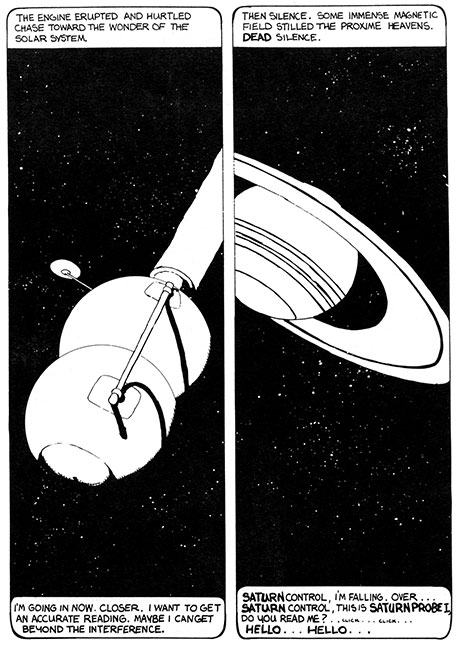
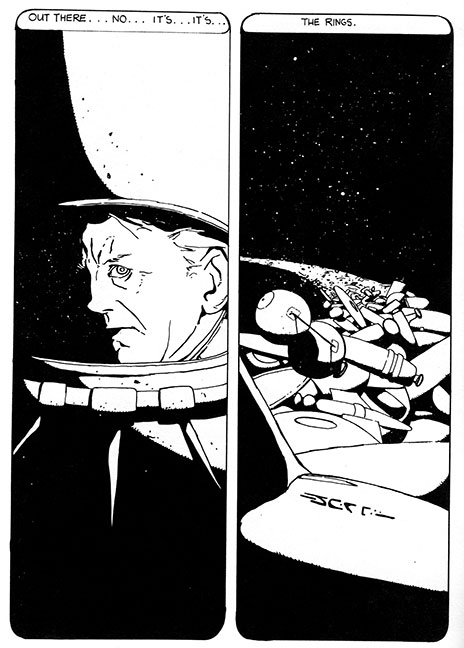
David continues with his memories of fandom below.
Q: What was your first exposure to fandom? A specific zine? A Convention?
My “fan-aticism” for comics went to the next level when at the age of ten I begged my parents to take me to the very first comic book convention in New York at the Statler Hilton. Here were my favorite comic artists in the flesh! I made my parents sit through the panels where comics were being seriously discussed by their creators. In a way it calmed their nerves that I was not alone in my strange fascination with comic books. My dad seemed to appreciate the fact that, for the most part these artists were men of his generation who wore jackets and ties.
I was a polite young man so, after a panel, if there was the opportunity, I would approach these guys, introduce myself and let them know what a fan I was of their work. I usually pointed out something about their style I felt was unique. My comments always seemed to be appreciated. I remember at this first convention when after a brief chat Gil Kane signed my program. I remember thinking his hair was combed exactly like Green Lantern’s.
But my actual favorite thing about these conventions was spending hours drooling over the original art that was for sale. The conventions became a major yearly event for me.
As I’m sure you know, these early conventions would be hardly recognizable by today’s extravaganza “comic-con” standards. They were relatively small and intimate affairs. Aspiring artists and writers from all over the country attended and were able to show their portfolios to editors and professional artists — as well as anybody else interested in taking a look. I was among this strange group — all of us toting around big art portfolios while touting our big ideas.
These events are where I initially met many of the remarkably talented “amateur” artists that I felt in my bones were bound for greatness. People like Bernie Wrightson, Jeff Jones, Mike Kaluta & Howard Chaykin. Their artwork blew my mind. These guys were the real deal… the young guns in town. Long haired hippie types that wanted to shake up the industry. It was the sixties! Protest and pot where in the air. Revolution… political, musical and sexual swirled all around us.
An interesting phenomenon at these conventions worth noting was that small groups of aspiring artists and writers would spontaneously gather around discussing the hot button topics of the day. We were all craving change. New and innovative styles of storytelling, better print quality, new formats geared to an older more sophisticated audience. We were passionate about artists having the ability to maintain the rights to their creations and being able to do material not censored by the Comics Code Authority. It was in this heady environment where the lightning bolt first struck telling me that I must produce my own independent publication someday.
I always seemed like the youngest guy in the room. Im 14-15 at the time but “played older.” I was able to fit in with these mostly 18-20 yr. olds. I was passionate and knowledgeable. I was a funny guy. I made them laugh. They liked me.
Next up is the first of several short sf fiction stories, The Catalonian Chapel. Unfortunately, the editor did not list detailed credits anywhere, so there is no evidence of who did this story, the others, or any unsigned illustrations. There are also watermarked images in the background of all the stories as well…but no credit, and they are too faint to identify.
Oh wait, that Adams guy did get some work! Evidence presents itself in the story below, Tangent. This is a few pages of evidence of the incredible visual realism Neal had, seemingly from day one. The note at the end of the last page is that it was an unpublished syndicated strip. Feast your eyeballs below (and see the complete story in the pdf accessible on my site).
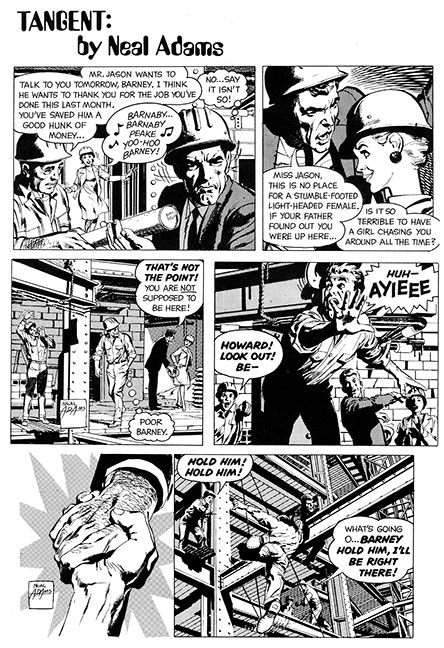
Bill Stillwell, really the main visual star of this fanzine, follows with the first of a couple stories, A Gift of Love. Bill loved illustrating gorgeous woman in all their glory (it would seem), and this strip is no different. On that subject and his social status at the time, Bill expounded through email to me, “I was always the designated driver. Didn’t smoke, drink, or use drugs (I got contact highs from all my friends, but the smoking thing discouraged me from doing it myself). But girls, well that was something I could do, very well. I have always loved women and more, I appreciate them. As far as their form goes, well, let’s just say that I was only a leg man professionally. ;-)” Also, Bill was lucky enough to get some valuable feedback on this story from none other than Frank Frazetta! He explains, “Some guy at one of the Phil Seuling Comic Cons in NYC offered me $1000 for A Gift of Love, but Frank Frazetta saw it, along with his pal, Roy Krenkel, and told me I shouldn’t sell it, because one day it would mean more to me, if I kept it. He was right (he was also very gracious in his praise and encouraging–praise from Caesar, indeed).”
You can see a few pages below.


Another single page of fiction is next, and then another story by Stillwell. This is called Lady Madona (written and penciled by Eric Pave). Bill told me about his beginnings below, again through email.
I began reading comics, like Superman and Captain Marvel in my pre-teens. When The Fantastic Four came out in 1961, and then Spider-Man, I became a Marvel fan. I was about 14, at the time. In those days, it was hard to learn who the comic artists were. After the fact, I learned that I liked Curt Swan and Kurt Scaffenberger on Superman, Carmen Infantino on The Flash. Later on, I really liked Frank Frazetta (who didn’t?), Jeff Jones, Berni Wrightson (who taught me to use a brush) and Jeff Jones. I also knew and admired Mike Kaluta, Barry Windsor-Smith (who, together with Jeff and Berni comprised The Studio) and, of course, Neal Adams, and Al Williamson.
I got involved in comic fandom as a result of my meeting all the above artists, plus Roy Krenkel, through my good friend and college classmate, Alan Asherman (author of the Star Trek Compendium). He introduced me to all these guys and we all hit it off very well. I admired all of them. I also admired Jack Kirby, for his explosive dynamism, though it was not my style, nor did I ever meet him. I never published my own fanzine, but did illustrations for a few, including Sal Quartuccio’s Hot Stuf’.
My aim as an artist was to continually improve and become a professional. I was, more or less, a realist, so the guys who drew what I considered to be “real” figures (even if idealized) appealed the most to me, like Frazetta and Adams and Big John Buscema. By that time, I preferred Marvel comics and my favorite character, to this day, is Thor. I think I did put effort into that goal. Had I continued in the field, I think I would have done pretty well.
For some reason, maybe it is the costuming, the visuals remind me of a young Howard Chaykin (see my comment on this later). Samples follow.
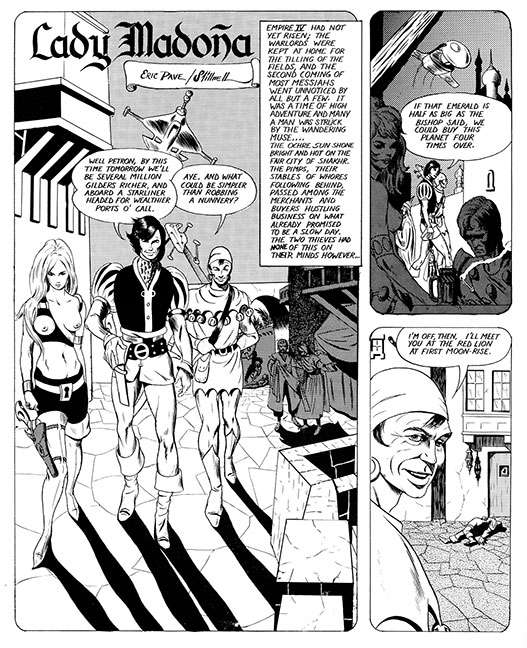
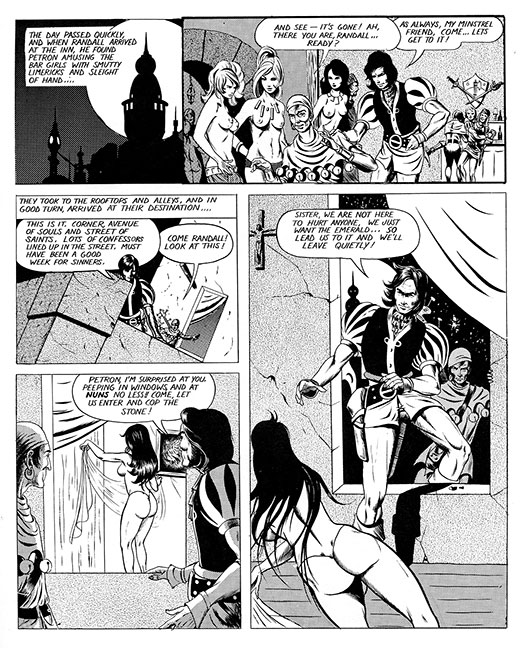
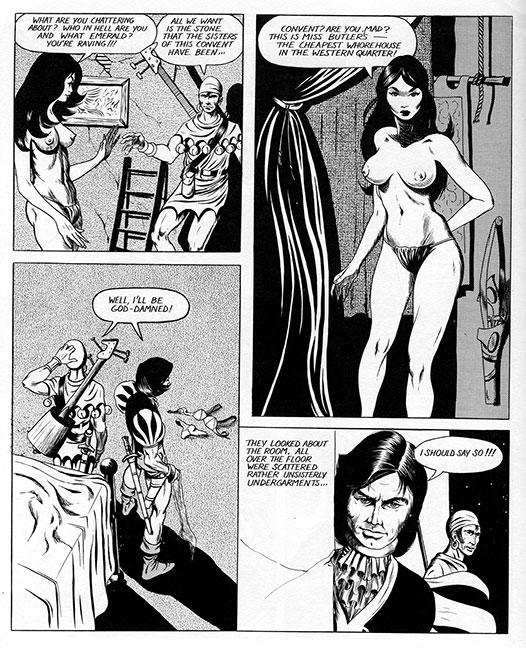
Editor Jablin has an uncanny knack to paint his remembrances with emotion and detail, as you can see below, with another answer to my question.
Q: Did you have any favorite zines as a reader?
At the time I really wasn’t into the whole zine scene. I think I bought a few issues of Squa Tront at a convention because they were printed so nicely. But usually whenever I picked one up the art looked amateurish to me. They had poor layout and design and shitty printing.
That changed when I stumbled upon an issue of Wally Wood’s Witzend. This was a game changer to me. Not so much a fanzine as a high quality “art” magazine which was being independently published, featuring professional comic artists “doing their thing” outside the limits of the comics code.
I thought, THIS is what I’d like to do — BUT featuring the up and coming artists that I know about!
I would spend time in bookstores carefully studying the layout and design of the hip counter culture magazines of the day. I was particularly inspired by a literary and art magazine called The Evergreen Review. It was smart, it was sexy it was funny. My three favorite attributes. This is where I wanted my publication to fit in, next to a copy of Evergreen on the shelves. I’m around 15 when I have this epiphany.
Step 1. Get the money to do it.
More fiction follows (Tanganyika), then a few pages of poetry and spot illustrations. The big wham bam visual in your face experience is delivered next by the incomparable Berni Wrightson. Conjure Woman contains the usual gorgeous ink work of Berni…the first page is below. You are welcome.

Stillwell has not left the building either, since the next feature is a teaser for an upcoming feature of his, seen after more Stillwell quotes. Bill was lucky enough to know some incredible artists, some of which are mentioned below, as well as his continually changing path in life.
After meeting the artists through my friend, Alan (Asherman), I was invited to join them every time they had a monthly meeting at Jeff Jones’ apartment in NYC–“First Fridays,” they were called.
I learned an enormous amount from all of them. And they were generous and encouraging to a fault. Wonderful group of supremely talented guys.
Roy Krenkel taught my how to spot blacks, Berni taught me the proper use of a Windsor Newton #3 brush for inking, Al Williamson showed me how to use a pen and Jeff and Mike taught me how to do composition. Vaughn Bode was a brilliant guy, a cartoonist with a devastating wit. It was like having a graduate course in art.I arrived as a professional with the publication of a single ink drawing for Venture Science Fiction. This led to my doing two pro strips for Jim Warren in Creepy #35 (Godslayer, which I wrote and illustrated, and The Cadaver, in Creepy #37, which I illustrated from a script, edited by Archie Goodwin).
I was a professional, but thereafter, I was swallowed whole by medical school, internship, residency, fellowship and marriage. And from there, I directly went into practice on Long Island. I still did occasional medical illustrations, for others, when asked, or when illustrating my own books.
Until I was injured in 2001 (broken back), I was an orthopedic surgeon, hip and knee specialist, Chairman of Orthopedic Surgery at St. Catherine of Siena Medical Center and Associate Professor of Clinical Orthopedic Surgery at State University of New York, at Stony Brook. I was also an Instructor at the College of Physicians & Surgeons of Columbia University. Pain from my back injury forced me into retirement in 2002, but except for being a little shorter than I used to be, I’m OK–not dead, obviously, and not paralyzed (though I could have been either). Better lucky than smart!
I do keep in touch with Mike Kaluta and Alan Asherman on Facebook. Jeff, Vaughn Bode and Berni are gone, as are Frank Frazetta Roy Krenkel, Gray Morrow and Al williamson–sad to say. I was privileged to know them all. I also still touch base with Howard Chaykin on FB, now and then, (see Eric Pave–his pen name–in the strip, Lady Madona, in Imagination, which I inked). [So I was right! There IS some Chaykin there! -Ken] I am very proud of both Mike and Howard, who have become institutions of excellence in themselves. So glad “I knew them when.”

The last story in the zine is by Jeff and Berni’s studio mate, Mike Kaluta. He does like those women up on slabs of stone, doesn’t he? This could be another one of those stories slated for the Web of Horror magazine.
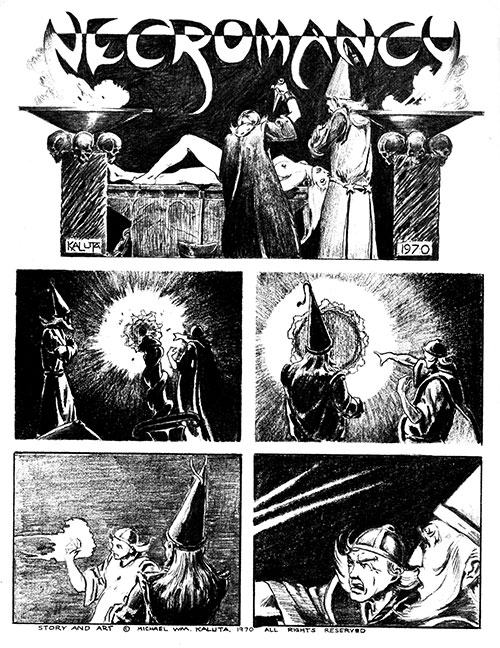
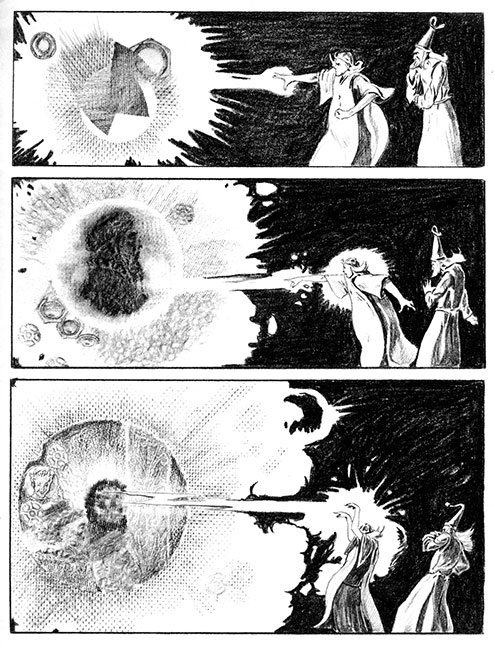
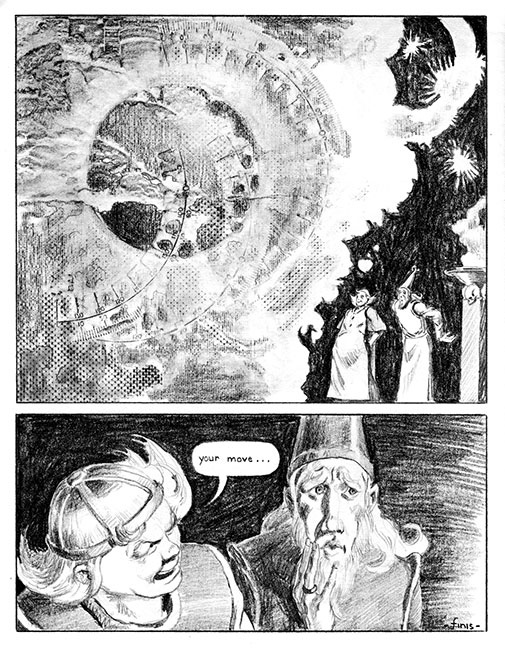
What? That Stillwell guy is still…well…here? That’s right…here he is on the backcover (hey, I am not complaining)! Also, a few final thoughts from Bill on the course of his life, especially in these later years.
Prior to my retirement, I also wrote and illustrated a massive book on surgery, called The Art of Total Hip Arthroplasty (fancy name for a hip replacement–one of my specialties). Still available on Ebay, I hear. Today, I write and sell medical information products for the lay person, self-illustrated, of course, available on my website, Dr. Bill’s Clinic here. I also sell my own line of pharmaceutical grade fish oil and other premium nutritional supplements here.
I also run a Facebook Group on health and extending longevity, which you and any of your members are invited to join (it’s FREE!) called “Live Longer and Prosper!” and can be seen here. Keeps me busy and out of the pool halls!
Anyway, that’s a capsule summary of my history in comic art. I like to think that I might have made a real name for myself, had I continued to improve and work. But as a surgeon, I was fortunate to touch the lives of thousands, who are alive and without pain, because of my surgeries and other treatments. Surgery is rather like living sculpture, in a way. And that’s not a bad legacy. I remain interested in comics and the art form, and read them, to this day. But I do think I made the right choice of career.
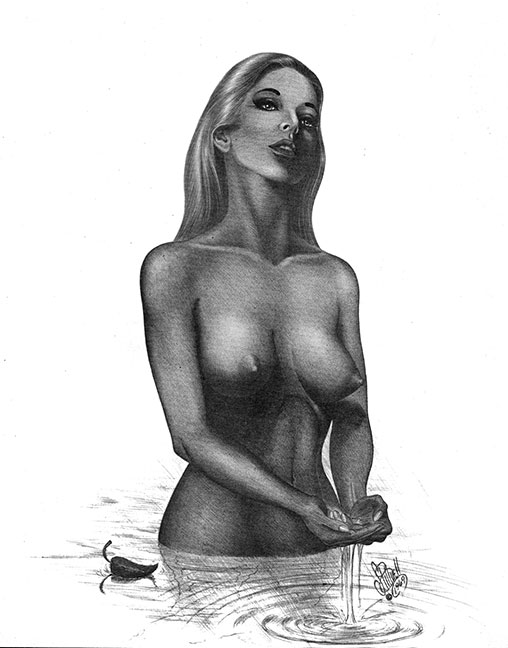
And now, the last few questions (again, remember, more are coming in an update) answered by editor Jablin, below.
Q: About how old were you when you put Imagination together?
It took about a year and a half from start to end. So I guess basically between the ages 15 and 17. By now my parents knew that I was serious about all this — so they were not shocked when I asked if I could use the money I received as gifts for my Bar Mitzvah to publish my own magazine.
I made a compelling case for my passion project. I did my homework and researched the hard costs of just printing a limited run of like 1,500 – 2,000 units with the kind of quality paper and art reproduction I was looking for. I had a “business plan” on how to recoup these costs and possibly even make a profit if I were able to sell the entire print run. My folks were under the impression that this would just be a one-off. In my mind what I was trying to accomplish would be like a TV pilot — a sample of what I’d like to continue to produce on an ongoing basis. I would share that dream with them another time however.
I was an excellent student at school with high grades so it was difficult for them to poo-poo it out of the box. The amount they agreed to invest was $2,500. That was a hard number “not a penny more.” I also had to keep my father in the loop with whatever I was doing. Imagination Publishing Co. was born of which I am now officially the self-appointed “editor and a publisher.” It’s a company run out of a basement in Flushing with only one employee who can only work after school.
Q: How did you come about your material?
I’m around 16 when I go to a convention with a mission and a real commitment for real money burning a hole in my bell bottom jeans.
First, I approached Mike Kaluta. I was a fan. The detail and quirky concepts in his work mesmerized me. I basically pitched him my idea of creating this sample “pilot magazine” that would demonstrate that a premium printed magazine packaged with the right mix of quality contributors, each whose work has something unique to say, could find this older more sophisticated audience if distributed in the proper venues — like bookstores — mixed in with the other big-time art and literary mags.
Of course, all contributors would retain the intellectual rights to their material as well as own their original artwork. I was completely upfront and said that money was being invested by my parents who believed in my ability to actually pull it off. I explained my lofty ambitions for quality layout and design. I showed him samples from other publications I was inspired by.
The one BIG catch was that I only had enough money to print a limited run of copies at this quality level. Therefore I would be unable to pay any fees to the artists and was looking for contributions to this venture from specific talent who were my favorites.
Mike wanted in.
Now from previous conventions I knew Kaluta was friendly with some of my other favorites like, Bernie Wrightson and Jeff Jones. I was aware that each had already contributed spot illustrations or small galleries of their drawings to other fanzines. What I wasn’t aware of at the time was that these three super talented artists shared a single studio space n the city. Mike invited me over to meet “the guys.”
When I look back I realize that I did all of this before I could drive. But I was a subway ninja on a mission. Gimme the address I’ll get there.
This shared space would later become known in the biz as “The Studio.” Other artists like Barry Smith would join. It evolved into a kind of cool comic artist commune. It was a large loft space with each artist having their own unique spacious work area. There was always great music playing. These guys had pretty braless girlfriends who would waft through occasionally. They were smoking pot and getting laid. I wanted out of my parents house so bad after seeing that.
But on this first visit it was just the four of us. To cut to the chase I did my passion pitch and the boys were all in.
We brainstormed together about a common format of some kind. I suggested something that could be done relatively quickly. I pitched the idea that the three of them each write and draw a 3 page story — something that would be representative of their unique sensibilities.
Strangely enough the idea for this three page story concept came to me while looking at this HUGE painting by Jeff Jones hanging on the wall. It was at least ten feet high. It depicted a nude women aging from a nubile nymph to a voluptuous women to a sagging octogenarian. They laughed when I described it as “beautiful, frightening and funny all at the same time.” [below you can see the painting I am pretty sure David is talking about]
I pointed to it and said, “that’s a whole story right there.” I went on about the “rule of three” in comedy (will touch on my comedy career in your last question). They all liked the idea of the quick rhythm of it. They really liked the beautiful/frightening/funny notion. The timing was perfect for them. They could all jump right in. They’d set a deadline and all finish at the same time. I was excited. They were excited. The challenge was afoot. The game was on.
BTW: Many years later I saw an image of that painting in a Jones retrospective online — but I never saw it published in print anywhere. Gotta wonder where that humongous original hangs today…
Next up. Neal Adams….
And that does it. A classy zine that I wish would have continued for much longer. Do not forget to look at the pdf in the Ink Stains section on my site at kenmeyerjr.com.
Thanks this time go out to Greg Turner, one of several, who, if their incredible zine collections turn up missing, should not consider me the thief. Nope, not me. Also, Emanuel Maris for input. And lastly, especially, Hulk-sized thanks go out to Bill Stillwell and David Jablin, who put aside some of their valuable time to answer my questions, which added an enormous amount of great content to this installment of Ink Stains!
POST POSTING NOTE: Thanks to Emanuel, you can see a pdf of the original printing of this zine from the Ink Stains section of my website here, look for the zine and then the link for “alternative printing.”
Ken Meyer Jr.
kenmeyerjr@yahoo.com


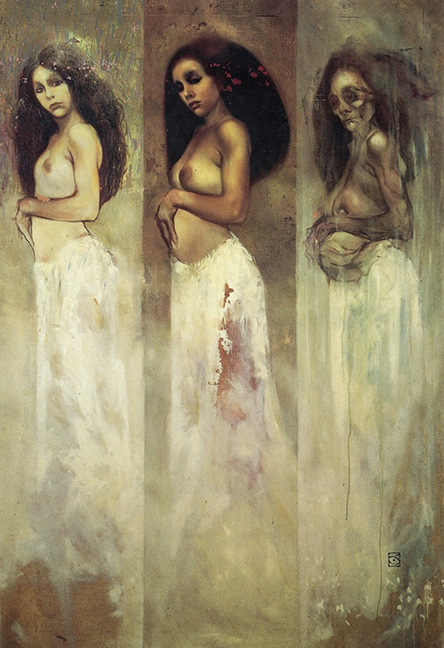
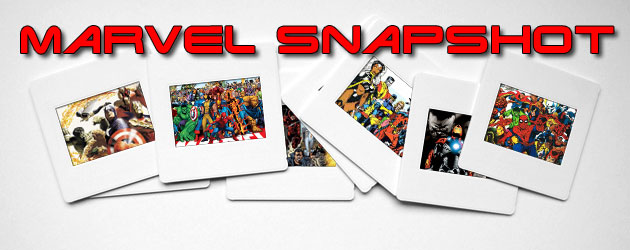

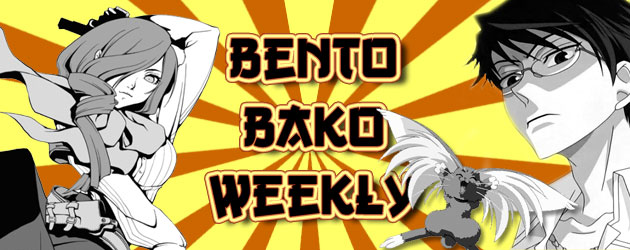
Still have my copy, looks brand new. It’s amazing how many fans at that time had such a love of the medium, and were willing to put every dime they had into supporting it. I think those days are long gone.
Oh yeah, definitely. And good ol Sal Q produced a ton of great stuff!
Ken, I know you will, but you have to expand/revise this article to include info and scans from the withdrawn/destroyed FIRST EDITION of Imagination #1.
wellll…if someone sends me all the scans….
I DID send you all the pages, in my email about the withdrawn first edition
Hi Manny, David Jablin here… Amazed that you remember that first run of the fanzine and still have a copy. I don’t think I do anymore and would love any scans you have of it, especially Al In Toiletland. I go into some detail about it in the full interview with Ken. I also recognize your name as a Jeff Jones expert. Any idea of what happened with Jeff’s painting I referred to in the Ink Stains interview of the three ages of a woman? I remember it being huge! It could hang in a museum. Also if you know who owns the originals of “Explored” I love to make an offer on them. Best regards and Happy holidays!
Hi David,
I worked with Manny on the Jeffrey Jones: The Definitive Reference book published by Vanguard a few years ago. I just ran across this post and have a question for you regarding Imagination 1. Did you create a separate print of Stillwell’s back cover that was distributed with the magazine? I would be interested in tracking one down if you have any suggestions there.
Also, while I am not at liberty to divulge the name, I do know that Three Ages of Woman has been owned by the same West Coast collector for many years.
…and, if anyone wants other info on ANY zine posted, feel free to post it in the comments, hinthint